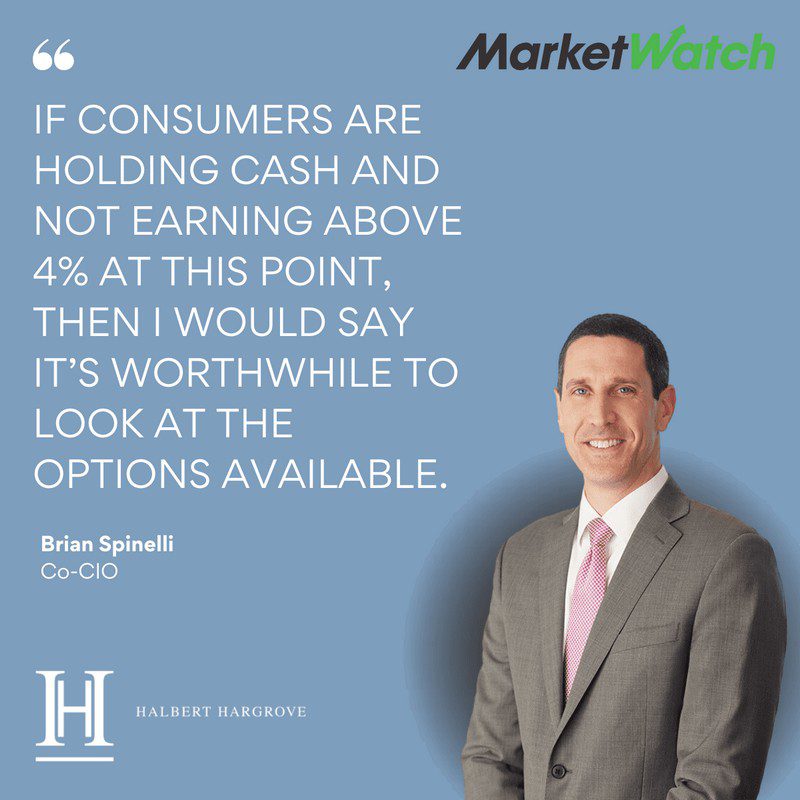The Federal Reserve declined to hike interest rates this month, and rates for CDs and savings accounts may stall, pros say.
By Andrew Shilling, MarketWatch featuring Brian Spinelli, CFP®, AIF®, Co-Chief Investment Officer
After levying 10 consecutive interest rate hikes since last March, the Federal Reserve on Wednesday said it would put a temporary freeze on
further increases by “holding the target range steady” in June. With the benchmark funds rate now halted at 5%-5.25%, up from nearly zero a year ago and its highest level since September 2007, pros say savings rates for high-yield savings accounts and certificates of deposit are also likely to stall as a result.
“Don’t expect further improvement in CD yields from a pause in interest rate hikes,” says Greg McBride, senior financial analyst at Bankrate.com. But he adds that if the Fed’s “pause proves to be short-lived, and they are seen raising interest rates again in July, this will give high-yield savings accounts a further boost but probably not until we’re closer to the next rate hike.”
Although the decision marks the end of the central bank’s fastest pace of rate increases in more than four decades, inflation figures still show consumer prices are well above the Fed’s 2% target. As a result, McBride suggests the interest rate freeze is likely temporary. “Through public comments, Federal Reserve officials have prepped markets for a pause,” he says, adding that the “pause may turn out to be short-lived however, with the Fed only skipping a rate hike this month but resuming in July.”
What is the impact on savings rates?
Looking back over the past year, it’s clear to see inflation has left its mark on nearly all parts of consumer markets. Since surpassing 9% last summer, borrowing costs have surged to their highest levels in years: home equity rates are their highest in two decades, credit card rates are well above 20% and rates on auto loans are their highest since 2010.
“If consumers are holding cash and not earning above 4% at this point, then I would say it’s worthwhile to look at the options available.”
— Brian Spinelli, Co-Chief Investment Office, Halbert Hargrove
On the other hand, because the rising funds rate impacts overall borrowing costs, banks typically alter the annual percentage yield, or APY, on high-yield savings accounts and CDs to attract new deposits and remain competitive. For some context, the average national deposit rate for savings accounts has increased in the past year to 0.40% from just 0.07% 12 months ago, according to the FDIC. For 12-month CDs, the average annual percentage yield, or APY, climbed to 1.59% from 0.21%.
Stephen Tuckwood, director of investments at Modern Wealth Management, says the pause is not only a great time for consumers to evaluate their own cost of borrowing, but it also stands as borrowed time to consider the interest being earned on their savings. “There are now attractive rates to be earned and it’s worthwhile for investors to shop around for the best rates on CDs,” Tuckwood says.
Savings expectations
Even as it has become more appealing to put money away into savings accounts and fixed-rate investment vehicles as a result of rising interest rates, it’s clear that the average American consumer is having a hard time finding that extra wiggle room. As many as 68% of Americans in a recent Bankrate report said they would not be able to cover their living expenses even for a month if they were to lose their job. One in four said they would be forced to put an unexpected $1,000 expense on a credit card and pay it off over time — and that’s without losing their job, the report found.
For those who are holding cash, Brian Spinelli, a certified financial planner and co-chief investment officer at Halbert Hargrove, says the rate pause will not change a lot for consumers in the short run. “If consumers are holding cash and not earning above 4% at this point, then I would say it’s worthwhile to look at the options available,” Spinelli says. “While cash returns still have a negative real rate of return (adjusting for inflation) there is still a need to hold cash if you know you are going to need it in the next two years and you need the certainty that it’s not going to decline in value for any period of time.”
Another consideration, Spinelli says, is that even though saving in either a high-yield savings account or a CD these days can indeed pay well above 5% (see the best rates available below), savers should also keep in mind that interest earned is taxable. “If they are in a high income tax bracket, that stated interest on savings accounts and CDs is not what they are going to keep,” he says, adding that tempering their expectations and “tack on how inflation impacts it too, and it’s really not an attractive long-term investment strategy.”
High-yield savings accounts or CDs?
Knowing whether to put your money into a high-yield savings account or fixed-rate investment vehicle such as a CD really comes down to your time horizon, Spinelli says. “For emergency reserves, leaving those in a savings account gives you the benefit of being able to draw it down on a moment’s notice,” he says, adding that “a CD is a bit more restrictive and the goal would be to hold them until they mature if you want to get the maximum amount of interest.”


